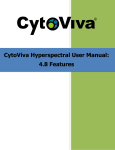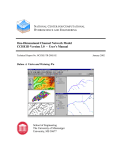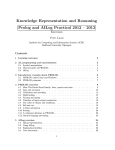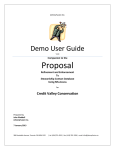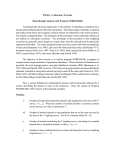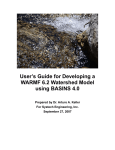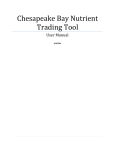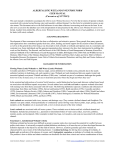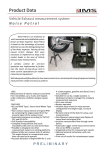Download GRTS Model Training
Transcript
GRTS Model Training US EPA: Andrea Matzke ([email protected]) Tetra Tech: Sabu Paul ([email protected]) What Will You Learn? • STEPL model 1. Create an Excel Model 2. Use BMP calculator • R5 model (a simple Excel model not just for Region 5) • Special discussion – BMP Efficiency Estimator – Online data server Part 1: STEPL What is STEPL? • Calculates nutrient (N, P, and BOD pollutants) and sediment loads by land use type and aggregated by watershed • Calculates load reductions as a result of implementing BMPs • Data driven and highly empirical • A customized MS Excel spreadsheet model – Simple and easy to use – Formulas and default parameter values can be modified by users (optional) with no programming required STEPL Users? • Basic understanding of hydrology, erosion, and pollutant loading processes • Knowledge (use and limitation) of environmental data (e.g., land use, agricultural statistics, and BMP efficiencies) • Familiarity with MS Excel and Excel Formulas Process Sources Groundwater Cropland Runoff Urban Load before BMP BMP Load after BMP Pasture Forest Erosion/ Sedimentation Feedlot Others STEP 1 STEP 2 STEP 3 STEP 4 STEPL Web Site Link to on-line Data server Link to download setup program to install STEPL program and documents Temporary URL: http://it.tetratech-ffx.com/stepl until moved to EPA server STEPL Main Program • Run STEPL executable program to create and customize spreadsheet dynamically STEPL Spreadsheet Composed of four worksheets BMPs Worksheet Each land use type within each watershed can have a separate BMP. Also it can be partial application. Total Load Worksheet Each row of results corresponds to a different watershed or project. Graphs Worksheet STEPL BMP Calculator • Calculates combined efficiency of a BMP train for a given land use. The use of BMP calculator requires the understanding of BMPs and their placement in the Series Reduced tillage watershed. Parallel Conventional tillage Reduced tillage Filter strip Conventional tillage Reduced tillage Settling Basin Combination Customized Menu Tip: To ensure that files are linked to the customized menu, set Excel Default file location to C\STEPL or D:\STEPL Step: Tools menu > Options submenu> General tab STEPL BMP Calculator • Describe schematically BMP configuration – Number and linkages – BMP type and efficiency – Land use area Use source area or original load as the weighting factor Delete Connection • Calculate combined efficiency Add BMP box Draw Connection Calculate combined efficiency Move BMP box New Features in 4.0 • Ability to specify different ways (by Subwatersheds or Individual Project Area vs. the Entire Watershed) to calculate sediment delivery • Calculation of Gully and stream bank erosion • Calculation of groundwater and pollutant output Hands-on Exercises Sample Problem Exercises • Exercise #1 – Estimate total annual load for a specific farm, and total load reduction resulting to implementation of a (single) BMP on croplands • Hypothetical watersheds based on Agricultural Statistics and NRCS data • Exercise #2 – Similar to Exercise #1 but with multiple BMPs • Exercise #3 – Similar to Exercise #1 but BMP trains implemented on croplands, and a single BMP on urban land • Exercise #4 – Similar to Exercise #1 but for multiple subwatersheds and BMP trains implemented on croplands, and pasture land • Exercise #5 – Hypothetical watersheds for demonstrating gully and streambank erosion Sample Problem Exercise #1 Estimate total annual load for a farm in Cullman County in Alabama Cullman County Agricultural Statistics of Alabama Based on 2002 Census of Agriculture, USDA National Agricultural Statistics Service Agricultural Statistics of Cullman County Land Information Average Farm Size (ac) 101 Average Cropland Size (ac) 64.2 Animal Information Animal Total Average Beef Cattle 39,018 28.58 Dairy Cattle 1,962 140.14 Swine (Hog) 152 11.69 Sheep 508 25.4 Chicken 1,572,552 14427.08 Based on 2002 Census of Agriculture, USDA National Agricultural Statistics Service • Sample Problem Exercise #1 Generate a new custom spreadsheet. Note that you may reuse a spreadsheet you created previously for a different project. – Click Start button (e.g., normally located at the Windows bottom left corner), then Program, STEPL, and STEPL to run the STEPL main executable program (stepl.exe in /STEPL folder) and display main interface – Select options. For Exercise #1, specify the following: • Specify number of watershed = 1 • Select first option under Option for Initialization (default selection – Set initial land use areas and animal numbers to zeros) – Click ok to create new spreadsheet – Click ok to the following message box – Save the spreadsheet using a new file name • For this example, you may save it to exercise1.xls – When the new spreadsheet is opened, click Ok button to enable stored formulas/equations in the spreadsheet • Sample Problem Exercise #1 Enter data in the Input Worksheet (numbers in red in spreadsheet) – By default, optional tables are not shown. Click yes to show the optional tables (Table 5-8) with their default values. Click no to hide them. – Select state = Alabama, and county = Cullman. Notice that initial values for Annual Rainfall and Number of Rain Days are automatically specified in Table 1 as you select a state or county. – Select a weather station = Al Birmingham FAA. Notice that correction factors change with the selected weather station. – In Table 1, enter the land use areas for your watershed (Refer next slide) – Also in Table 1, Select the feedlot percent paved assuming feedlot area is not zero. Default value = 0-24%. Sample Problem Exercise #1 • Enter data in the Input Worksheet (numbers in red in spreadsheet), cont’d. – Also enter data into Tables 2 and 3. Set the number of months manure applied to 3 – In Table 4, examine the initial USLE parameter values for each land use type which were automatically specified as you selected the state and county. Table 1 Cropland Pastureland Feedlots Table 2 75 Beef Cattle 20 5 Dairy Cattle Swine (Hog) Sheep Chicken Table 3 10 10 5 10 100 No. of Septic Systems Population per Septic System 2.38 Septic Failure Rate, % 0.87 5 You can always change the default and initial data when local data are available. • Sample Problem Exercise #1 Examine estimated load in Total Load and Graph worksheets and enter the results below: Total Annual N Load (lb/yr): ________ 4699.1 Total Annual P Load (lb/yr): ________ 1042.7 Total Annual Sediment Load (ton/yr): ________ 428.5 Amount and source with highest annual load contribution: N load (lb/yr): __2276.2.0 What source: ___ Cropland P load (lb/yr): __705.6 What source: ___ Cropland Sediment load (lb/yr): _406.1 What source: ___ Cropland Note that load reduction = 0 since you have not specified any BMP yet – see next slide Sample Problem Exercise #1 For the same farm area, estimate total annual load reduction assuming reduced tillage is practiced in cropland areas • Enter BMP data in BMPs worksheet – In Table 1 which is for cropland areas, select Reduced Tillage System under BMP column. Note that initial values of BMP efficiencies are automatically specified with the selected BMP. Sample Problem Exercise #1 • Examine estimated load reduction in Total Load and Graph worksheets and enter the results below: Total Annual N Load Reduction (lb): ______ 1511.8 Total Annual P Load Reduction (lb): _______467.6 Total Annual Sediment Load Reduction (ton): _____304.6 Source with highest annual load contribution after BMP: N load (lb): ___2135.9 What source: __Feedlots P load (lb): ___292.9 What source: __ Feedlots Sediment load (lb): ___101.5 What source: __Cropland End of Problem Exercise #1 – Try adjusting your input data and reexamine the results. Sample Problem Exercise #1 • • In the Input worksheet check the box next to Groundwater load calculation Examine estimated load in Total Load and Graph worksheets and enter the results below: Total Annual N Load (lb/yr): ________ 5221.0 Total Annual P Load (lb/yr): ________ 1065.2 Total Annual Sediment Load (ton/yr): ________ 428.5 Amount and source with highest annual load contribution: N load (lb/yr): __2135.92 What source: ___ Feedlot P load (lb/yr): __292.95 What source: ___ Feedlot Sediment load (lb/yr): _101.52 What source: ___ Cropland End of Problem Exercise #1 – Try adjusting your input data and reexamine the results. Sample Problem Exercise #2 For the same farm area, estimate total annual load reduction assuming reduced tillage is practiced in cropland areas and Solids Separation Basin BMP on feedlots • Create a spreadsheet for this project or exercise. – Instead of generating a new custom spreadsheet using the STEPL main executable program, you will be using the spreadsheet in the previous exercise. – Save the spreadsheet used for Exercise #1 to save recent changes. – Save this spreadsheet with a new name (exercise2.xls, be sure to save the file as *.xls type). This new spreadsheet will be used for Exercise #2. Sample Problem Exercise #2 • Enter new data in the Input Worksheet – Note that all the input data entered in the previous spreadsheet are still valid – Only modification is an additional BMP • Sample Problem Exercise #2 Examine estimated load reduction in Total Load and Graph worksheets and enter the results below: Total Annual N Load Reduction (lb): ____2259.4 Total Annual P Load Reduction (lb): _____ 558.4 Total Annual Sediment Load Reduction (ton): ____ 304.6 Source with highest annual load contribution after BMP: N load (lb): _1388.3 What source: __Feedlots P load (lb): _237.97 What source: __Cropland Sediment load (lb): _101.5 What source: __Cropland Note that load reductions have been calculated since BMPs have been already specified in the previous exercise. For this exercise, assume that the same BMPs are installed for all cropland and urban areas in the 8-digit watershed. Sample Problem Exercise #3 Estimate total annual load and load reduction for a watershed that consists more than one farm where all croplands are practicing reduced tillage and filter strips (shown below) and urban open spaces has LID/Bioretention: Reduced tillage Filter strip Assume all croplands is implementing the above BMP train Sample Problem Exercise #3 • Create a spreadsheet for this project or exercise. – Save the spreadsheet used in Exercise #2 to exercise3.xls. – Enter new data in the Input Worksheet Sample Problem Exercise #3 • Examine estimated load in Total Load and Graph worksheets and enter the results below: Total Annual N Load (lb): ____17015.2 Total Annual P Load (lb): ____ 4108.5 Total Annual Sediment Load (ton): ___ 1526.7 Source with highest annual load contribution: N load (lb): __11208.3 What source: ___Cropland P load (lb): __3176.6 What source: ____Cropland Sediment load (lb): __1467.7 What source: __Cropland Sample Problem Exercise #3 • Enter BMP data in BMP worksheet – In Table 1, which is for cropland areas, select “CombinedBMP calculated” under BMP column to indicate that we have a “Reduced Tillage-Filter Strip” BMP train in croplands. – Note that the N, P, BOD, and Sediment BMP efficiencies remained zero. If you have the combined efficiency values for this particular BMP train, enter them in Table 7 (number in red). These values will be reflected in Table 1 and in other tables (i.e., if the same BMP train is implemented for other land uses). – If you do not have the values, you may use the BMP calculator (next step) • Sample Problem Exercise #3 Use BMP Calculator to estimate combined efficiencies of the BMP train – Run the BMP Calculator by selecting the STEPL/BMP Calculator menu of the STEPL spreadsheet. If the system cannot find the BMP Calculator program, navigate to /STEPL folder and select BMPCalculator.exe – Using the BMP Calculator interface, do the following (refer back to slide 13 for steps in using BMP Calculator): • Add two BMP boxes (one each for Reduced Tillage, and Filter Strip) • Enter BMP information (type, area, etc.) for each BMP box by double-clicking the box (Question: What is the area associated with the filter strip) • Specify the connection between the two BMPs (Question: Which BMP should be upstream). You may move the boxes to make them more readable • Calculate the combined efficiencies for N, P, BOD, and Sediment (0.865, 0.863, ND, 0.913). • Enter the combined efficiencies in Table 7 of STEPL spreadsheet. Note the efficiencies are reflected in Table 1. Sample Problem Exercise #3 • Click Urban BMP Tool – Select Open Space under urban land use options->Select LID/Bioretention under Available LID/BMP -> Click Apply LID/BMP You can always manually change the initial BMP efficiencies if local data are available. If your BMP is not in the selection list, you may use STEPL-View/Edit BMP List menu to add your BMP to the database (please refer to the user manual) • Sample Problem Exercise #3 Examine estimated load reduction in Total Load and Graph worksheets and enter the results below: Total Annual N Load Reduction (lb): ___9929.3 Total Annual P Load Reduction (lb): ____ 2833.4 Total Annual Sediment Reduction (ton): ____ 1340.0 Source with highest annual load contribution after BMP: N load (lb): __3952.4 What source: __ Feedlot P load (lb): __658.6 What source: __Feedlot Sediment load (lb): __127.7 What source: __Cropland End of Problem Exercise #3 – Try adjusting your input data and reexamine the results. Sample Problem Exercise #4 • Generate a new custom spreadsheet. – Similar to exercise 1 create a new spreadsheet, but specify two watersheds this time ( Program-> STEPL-> STEPL) – Select options. For Exercise #4, specify the following: • Specify number of watershed = 2 • Select first option under Option for Initialization (default selection – Set initial land use areas and animal numbers to zeros) – Click ok to create new spreadsheet – Click ok to the following message box – Save the spreadsheet using a new file name • For this example, you may save it to exercise4.xls – When the new spreadsheet is opened, click Ok button to enable stored formulas/equations in the spreadsheet Sample Problem Exercise #4 • Enter data in the Input Worksheet (numbers in red in spreadsheet) – Select state = Alabama, and county = Cullman. – Select a weather station = Al Birmingham FAA. Sample Problem Exercise #4 • Enter data in the Input Worksheet (numbers in red in spreadsheet), cont’d Sample Problem Exercise #4 • Cropland in watershed 1 has the same BMP train as in example 2, • Cropland in watershed 2 has filter strip • Pastureland in both watersheds has filter strip Reduced tillage Filter strip Assume all croplands in watershed 1 is implementing the above BMP train Sample Problem Exercise #4 • Cropland in watershed 1 has the same BMP train as in example 2, • Cropland in watershed 2 has filter strip • Pastureland in both watersheds has filter strip • Sample Problem Exercise #4 Examine estimated load reduction in Total Load and Graph worksheets and enter the results below: Total Annual N Load Reduction (lb): ___ 6909.5 Total Annual P Load Reduction (lb): ____ 1920.5 Total Annual Sediment Reduction (ton): ____ 980.3 Source with highest annual load contribution after BMP: N load (lb): __2844.1 What source: __ Feedlot P load (lb): __528.7 What source: __Cropland Sediment load (lb): __287.6 What source: __Cropland • Sample Problem Exercise #4 In the Input worksheet, check the box next to Treat all the subwatersheds as parts of a single watershed. • Examine estimated load reduction in Total Load and Graph worksheets and enter the results below: Total Annual N Load Reduction (lb): ___ 6184.3 Total Annual P Load Reduction (lb): ____ 1641.3 Total Annual Sediment Reduction (ton): ____ 753.6 Source with highest annual load contribution after BMP: N load (lb): __2844.1 What source: __ Feedlot P load (lb): __483.79 What source: __Cropland Sediment load (lb): __351.18 What source: __Cropland End of Problem Exercise #4 – Try adjusting your input data and reexamine the results. • Sample Problem Exercise #5 Generate a new custom spreadsheet. – Similar to exercise 1 create a new spreadsheet, but specify three watersheds this time ( Program-> STEPL-> STEPL) – Select options. For Exercise #5, specify the following: • • • • Specify number of watershed = 3 Specify gully formations = 2 Specify impaired streambanks = 2 Select second option under Option for Initialization (Test STEPL model with non-zero initial numbers) – Click ok to create new spreadsheet – Click ok to the following message box – Save the spreadsheet using a new file name • For this example, you may save it to exercise5.xls – When the new spreadsheet is opened, click Ok button to enable stored formulas/equations in the spreadsheet Sample Problem Exercise #5 • Enter data in the Input Worksheet (numbers in red in spreadsheet) – Select state = Alabama, and county = Cullman. – Select a weather station = Al Birmingham FAA. Sample Problem Exercise #5 • Click Gully and Streambank Erosion button in BMPs Worksheet and enter data in the Gully&Streambank Worksheet (numbers in red in spreadsheet) Sample Problem Exercise #5 • Examine estimated load reduction in Total Load and Graph worksheets and enter the results below: Total Annual N Load Reduction (lb): ___ 20.0 Total Annual P Load Reduction (lb): ____ 7.7 Total Annual Sediment Reduction (ton): ____ 13.8 End of Problem Exercise #5 – Try adjusting your input data and reexamine the results. BMP Calculator More Exercises for BMP Calculator • Try different BMP trains in the BMP Calculator. Note that you may define as many trains as you want and calculate each BMP train’s combined efficiency at the same time in the same window. You don’t need to open a separate BMP window for each BMP train (see illustration below). Need of BMP Calculator • When is BMP Calculator needed? Not needed - No combined efficiency calculation Needed - Each land use type uses more than one type of BMP BMP Calculator – Example 1 1 2 3 Each box represents 100 ac Crop Regular Tillage Crop Reduced Tillage Filter Strip Load BMP Calculator – Example 2 1 3 2 Each box represents 100 ac Forest Road Grass Planting Forest No Onsite Road BMP Filter Strip Load BMP Calculator – Example 3 1 2 3 Each box represents 100 ac Urban Grass Swale Load Urban Porous Pavement Adding BMP Data Add New Data to BMP List • In STEPL customized menu, click “View/Edit BMP List” • BMPList worksheet is shown, add or delete BMPs Customized menu Example: New data inserted here STEPL: Add New Data to BMP List Update BMP button (BMPList worksheet) New BMP added! New BMP added! (BMPs worksheet) • Click “Update BMP Data” button to update the BMP selections in the BMPs worksheet • Click “Save Updates” to save changes to text files (comma delimited) – C:or D:\Stepl\Support\AllBMPstepl.csv – C: or D:\Stepl\Support\AllBMP.csv Part 2: Region 5 Model R5 model is not limited to Region 5 If controls of the model does not work, set EXCEL > Tools > Macro >Macros >Security to Medium Region 5 model has five functional worksheets. Region 5 Load Estimation Model • Introduction – Provide a general estimate of pollutant reduction at the source level – Initially developed by Indiana Department of Environmental Management (IDEM) based on Michigan DEQ’s pollution control manual for section 319 watersheds. Gully Erosion: Calculate Load Reduction • • Select a soil texture (e.g. sand, loamy sand) Enter gully dimensions and the number of years since the gully formed Gully Stabilization • Load Average annual erosion during the life of the gully (t/y) = Volume x Soil Weight / Years Nutrient load = Annual Erosion x Soil Nutrient Conc. x Correction Factor • Load Reduction after implementing gully stabilization – Specify reduction efficiency (100% efficiency by default) – Reduction is equal to annual erosion x user-specified efficiency Volume = (Top Width +Bottom Width) x Depth x Length / 2 Gully Erosion: Nutrient Correction Factor • Correction Factor – Smaller soil particles -> larger aggregated surface area -> more nutrients attached Soil Texture Nutrient Correction Factor Clay 1.15 Silt 1.00 Sand 0.85 Peat 1.50 • • Stream Bank Erosion— Calculation Select a soil texture (e.g. silty clay) Enter the dimensions of the eroding stream banks Stream Bank Erosion • Load (Channel Erosion) = Length * Height * Lateral Recession rate * Soil weight • Load Reduction = Load * Load reduction efficiency Determining Lateral Recession Rate by Field Observation Lateral Recession Rate (ft/yr) Category Description 0.01 – 0.05 Slight Some bare bank, no exposed roots 0.06 – 0.2 Moderate Bank is mostly bare 0.3 – 0.5 Severe Bank is bare with exposed roots Very Severe Bank is bare with fallen trees 0.5+ Agricultural Practices—Usage • Check BMPs: Agricultural field practices and filter strips (check both) • Select a state and a county for default USLE parameter values • Modify the default USLE parameter values for local conditions, especially the cover factor C and the supporting practice factor P to reflect the before and after treatment effects Agricultural Practices—Usage 2 • Enter contributing areas (e.g. 50 acres) • Select a soil texture (e.g. silt) Note: This worksheet is also applicable to other cases (mining, construction sites) when USLE is used. Feedlot Pollution Reduction • Load – – – – – Enter a contributing area (e.g. 1.74 acre) Specify the percentage of paved area (e.g. 75-100%) Select state and a county (Pennsylvania, Lycoming) Select Weather Station (NY New York Central Park) Enter animal count for each type Feedlot Pollution Reduction • Load Reduction – – Select a feedlot best management practice (e.g. waste management system) System calculates load reduction using pre-assigned (BOD, P, N) efficiencies for the selected BMP Urban Pollution Reduction • Load – – Enter size (acres) of storm water sewered and unsewered areas for each urban land use subclass System calculates load using default unit loads for each land use sub class Note: Storm sewers Urban Pollution Reduction • Load Reduction – – Select BMP System calculates load using default BMP efficiencies for the selected BMP Region 5 model vs. STEPL 1 • Region 5 model – – • Calculates load at the source level Sources are independent (no relationship between worksheets) STEPL – – – – Calculates load for different sources at source and watershed level Sources are related in watershed User can specify and update BMP list BMP calculator for complex BMP arrangements Part 3: Special Discussion BMP Efficiency Estimator • Simple calculator to estimate BMP efficiency for non structural BMP • Estimates efficiency due tochanges in cropping patterns or soil support practices BMP Efficiency Estimator – contd. Other Alternative Load Models - Simple Model Simple Simple Method FHWA SLOSS/ PHOSPH Watershed Field or Watershed Land Use Pollutant Event or Continuous BMP Data Reqt’s Level of Effort Watershed Urban N, P Event Low Low Both Both Urban Rural N, P P, Sed Event Event Low Low Low Low Both Both P Event Simple Medium Medium Reference: List of alternative load and load reduction models, STEPL Web site. Other Alternative Load Models – Mid Range Model Field or Watershed Land Use Pollutant Event or Continuous BMP Data Reqt’s Level of Effort Mid Range AGNPS Both Rural N, P, Sed Both Detailed Medium Medium to High to High GWLF Both Both N, P, Sed Both Simple Low to Low to Medium Medium Other Alternative Load Models - Detailed Model Field or Watershed Land Use Pollutant Event or Continuous BMP Data Reqt’s Level of Effort Detailed/Complex ANSWERS Both Rural N, P, Sed Both Detailed Medium Medium to High to High GLEAMS Field Rural N, P, Sed Both HSPF Both Both N, P, Sed Both SWAT SWMM WEPP Both Both Both Rural Both Rural N, P, Sed Both N, P, Sed Both Sed Continuous Detailed Medium to High Detailed Medium to High Detailed Medium Detailed High Detailed Low to High Medium to High Medium to High Medium High Low to High STEPL Online Input Data Server ONLY FOR PRACTICE!! STEPL Online Input Data Server Data is available at HUC and county intersection (HUCO Polygon) Generate data summaries Note: Zoom in further to display polygon IDs STEPL Online Input Data Server: Basic Report Data is summarized by HUCO polygon STEPL: Discussion • Watershed vs. subwatershed – STEPL model is not limited to subwatershed (can apply to farms, scenarios, etc.) – Watershed size (make the subwatershed small enough to reflect BMP effectiveness. – You want to know the reduction at the local subwatershed level (Sum of loads from subwatersheds ≠ load at the watershed outlet because of the transport loss in the main stem.) • • • • • • • Local weather data How to use the user-defined land use? Septic failure rate clarification Add new BMPs to the list Small treated area vs. large watershed R5 100% efficiency assumptions Estimate BMP efficiencies using USLE tables Some useful data! Estimate BMP Efficiency Using USLE C Value Table I Generalized Values of Cover and Management Factor (C) for Field Crops East of the Rocky Mountains (Stewart et al 1975). Crop, rotation & management b/ Productivity a/ (Please use the abbreviation table below!) High Moderate ----------------------------------------------------------------------------------------------------------------Continuous fallow, tilled up and down slope 1.00 1.00 CORN 1 C, RdR, fall TP, conv (1) 0.54 0.62 2 C, RdR, spring TP, conv (1) 0.50 0.59 3 C, RdL, fall TP, conv (1) 0.42 0.52 4 C, RdR, wc seeding, spring TP, conv (1) 0.40 0.49 5 C, RdL, standing, spring TP, conv (1) 0.38 0.48 6 C, fall shred stalks, spring TP, conv (1) 0.35 0.44 7 C(silage)-W(RdL,fall TP) (2) 0.31 0.35 8 C, RdL, fall chisel, spring disk, 40-30% re (1) 0.24 0.30 9 C(silage), W wc seeding, no-till p1 in c-k W (1) 0.20 0.24 10 C(RdL)-W(RdL, spring TP) (2) 0.20 0.28 11 C, fall shred stalks, chisel p1, 40-30% re (1) 0.19 0.26 12 C-C-C-W-M, RdL, TP for C, disk for W (5) 0.17 0.23 13 C, RdL, strip till row zones, 55-40% re (1) 0.16 0.24 14 C-C-C-W-M-M, RdL, TP for C, disk for W (6) 0.14 0.20 15 C-C-W-M, RdL, TP for C, disk for W (4) 0.12 0.17 16 C, fall shred, no-till pl, 70-50% re (1) 0.11 0.18 17 C-C-W-M-M, RdL, TP for C, disk for W (5) 0.087 0.14 18 C-C-C-W-M, RdL, no-till pl 2nd & 3rd C (5) 0.076 0.13 19 C-C-W-M, RdL, no-till pl 2d C (4) 0.068 0.11 20 C, no-till pl in c-k wheat, 90-70% re (1) 0.062 0.14 21 C-C-C-W-M-M, no-till p1 2d & 3rd C (6) 0.061 0.11 22 C-W-M, RdL, TP for C, disk for W (3) 0.055 0.095 23 C-C-W-M-M, RdL, no-till pl 2d C (5) 0.051 0.094 24 C-W-M-M, RdL, TP for C, disk for W (4) 0.039 0.074 25 C-W-M-M-M, RdL, TP for C, disk for W (5) 0.032 0.061 26 C, no-till pl in c-k sod, 95-80% re (1) 0.017 0.053 Estimate BMP Efficiency Using USLE C Value Table II Generalized Values of Cover and Management Factor (C) for Field Crops East of the Rocky Mountains (Stewart et al 1975). Crop, rotation & management b/ Productivity a/ (Please use the abbreviation table below!) High Moderate ----------------------------------------------------------------------------------------------------------------COTTON /c 27 Cot, conv (western plains) (1) 0.42 0.49 28 Cot, conv (south) (1) 0.34 0.40 MEADOW (HAY) 29 Grass & legume mix 0.004 0.01 30 Alfalfa, lespedeza or sericia 0.020 31 Sweet clover 0.025 SORGHUM, GRAIN (western plains) 32 RdL, spring TP, conv (1) 0.43 0.53 33 No-till pl in shredded 70-50% re 0.11 0.18 SOYBEANS /c 34 B, RdL, spring TP, conv (1) 0.48 0.54 35 C-B, TP annually, conv (2) 0.43 0.51 36 B, no-till pl 0.22 0.28 37 C-B, no-till pl, fall shred C stalks (2) 0.18 0.22 WHEAT 38 W-F, fall TP after W (2) 0.38 39 W-F, stubble mulch, 500 lb re (2) 0.32 40 W-F, stubble mulch, 1000 lb re (2) 0.21 41 Spring W, RdL, Sept TP, conv (ND,SD) (1) 0.23 42 winter W, RdL, Aug TP, conv (KS) (1) 0.19 43 Spring W, stubble mulch, 750 lb re (1) 0.15 44 Spring W, stubble mulch, 1250 lb re (1) 0.12 45 Winter W, stubble mulch, 750 lb re (1) 0.11 46 Winter W, stubble mulch, 1250 lb re (1) 0.10 47 W-M, conv (2) 0.054 48 W-M-M, conv (3) 0.026 49 W-M-M-M, conv (4) 0.021 -------------------------------------------------------------------------------------------------------------- Estimate BMP Efficiency Using USLE C Value Table III Values of Cover and Management Factor (C) for Pasture and Woodland (Novotny & Chesters, 1981). Cover Value -------------------------------------------------------------------------------------------------------Permanent pasture, idle land, unmanaged woodland 95-100% ground cover as grass 0.003 as weeds 0.01 80% ground cover as grass 0.01 as weeds 0.04 60% ground cover as grass 0.04 as weeds 0.09 Managed woodland 75-100% tree canopy 0.001 40-75% tree canopy 0.002-0.004 20-40% tree canopy 0.003-0.01 -------------------------------------------------------------------------------------------------------- For example: Increase ground cover from 60% to 80% will reduce erosion about 75% Estimate BMP Efficiency Using USLE C Value Table IV Generalized Values of Cover and Management Factor (C) for Field Crops East of the Rocky Mountains (Stewart et al 1975). Notes and Abbreviations a/. High level exemplified by long-term yield averages greater than 75 bu/ac corn or 3 ton/ac hay or cotton management that regularly provides good stands and growth. b/. Numbers in parentheses indicate numbers of years in the rotation cycle. (1) indicates a continuous one-crop system. c/. Grain sorghum, soybeans or cotton may be substituted for corn in lines 12,14,15, 17-19, 21-25 to estimate values for sod-based rotations. Abbreviations: B C c-k conv cot lb re % re xx-yy% re RdR RdL TP soybeans F fallow corn M grass & legume hay chemically killed pl plant conventional W wheat cotton wc winter cover pounds of residue per acre remaining on surface after new crop seeding percentage of soil surface covered by residue mulch after new crop seeding xx% cover for high productivity, yy% for moderate residues (corn stover, straw, etc.) removed or burned residues left on field (on surface or incorporated) turn plowed (upper 5 or more inches of soil inverted, covering residues Estimate BMP Efficiency Using USLE P Value Table Values of Supporting Practice Factor (P) (Stewart et al 1975). Practice Slope(%): 1.1-2 2.1-7 7.1-12 12.1-18 18.1-24 -------------------------------------------------------------------------------------------------------------------------------No support practice 1.00 1.00 1.00 1.00 1.00 Contouring 0.60 0.50 0.60 0.80 0.90 Contour strip cropping R-R-M-M /a 0.30 0.25 0.30 0.40 0.45 R-W-M-M 0.30 0.25 0.30 0.40 0.45 R-R-W-M 0.45 0.38 0.45 0.60 0.68 R-W 0.52 0.44 0.52 0.70 0.90 R-O 0.60 0.50 0.60 0.80 0.90 Contour listing or ridge planting 0.30 0.25 0.30 0.40 0.45 ½ ½ ½ ½ 0.5/n 0.6/n 0.8/n 0.9/n½ Contour terracing /b 0.6/n a/. R = row crop, W = fall-seeded grain, M = meadow. The crops are grown in rotation and so arranged on the field that row crop strips are always separated by a meadow or winter-grain strip. b/. These factors estimate the amount of soil eroded to the terrace channels. To obtain off-field values, multiply by 0.2. n = number of approximately equal length intervals into which the field slope is divided by the terraces. Tillage operations must be parallel to the terraces. For example: Contouring will reduce sediment by 1040% depending on slope Estimate Runoff Changes Using Curve Number Runoff Curve Numbers (Antecedent Moisture Condition II) for Cultivated Agricultural Land (Soil Conservation Service, 1986). Land Use/Cover Hydrologic Condition A B C D <- Soil Hydrologic Group -----------------------------------------------------------------------------------------------------------Fallow Bare Soil 77 86 91 94 Crop residue cover (CR) Poor * 76 85 90 93 Good 74 83 88 90 Row Crops Straight row (SR) Poor 72 81 88 91 Good 67 78 85 89 SR+CR Poor 71 80 87 90 Good 64 75 82 85 Contoured (C) Poor 70 79 84 88 Good 65 75 82 86 C+CR Poor 69 78 83 87 Good 64 74 81 85 Contoured & terraced (C&T) Poor 66 74 80 82 Good 62 71 78 81 C&T + CR Poor 65 73 79 81 Good 61 70 77 80 Small SR Poor 65 76 84 88 Grains Good 63 75 83 87 SR+CR Poor 64 75 83 86 Good 60 72 80 84 C Poor 63 74 82 85 Good 61 73 81 84 C+CR Poor 62 73 81 84 Good 60 72 80 83 C&T Poor 61 72 79 82 Good 59 70 78 81 C&T + CR Poor 60 71 78 81 Good 58 69 77 80 CloseSR Poor 66 77 85 89 seeded or Good 58 72 81 85 broadcast C Poor 64 75 83 85 legumes or Good 55 69 78 83 rotation C&T Poor 63 73 80 83 meadow Good 51 67 76 80 ------------------------------------------------------------------------------------------------------------- Estimate Runoff Changes Using Curve Number II Runoff Curve Numbers (Antecedent Moisture Condition II) for Other Rural Land (Soil Conservation Service, 1986). Hydrologic Soil Hydrologic Land Use/Cover Condition Group A B C ------------------------------------------------------------------------------------------------------------------------------------------Pasture, grassland or range Poor/a 68 79 86 - continuous forage for grazing Fair 49 69 79 Good 39 61 74 Meadow – continuous grass, protected from grazing, generally mowed for hay 30 58 71 D 89 84 80 78 Brush - brush/weeds/grass mixture with brush the major element Poor/b Fair Good 48 35 30 67 56 48 77 70 65 83 77 73 Woods/grass combination (orchard or tree farm) /c Poor Fair Good 57 43 32 73 65 58 82 76 72 86 82 79 Woods Poor/d Fair Good 45 36 30 66 60 55 77 73 70 83 79 77 Farmsteads – buildings, lanes, driveways and surrounding lots 59 74 82 86 ------------------------------------------------------------------------------------------------------------------------------------------a) Poor: 50% ground cover or heavily grazed with no mulch; Fair: 50 to 75% ground cover and not heavily grazed; Good: > 75% ground cover and lightly or only occasionally grazed. b) Poor: < 50% ground cover; Fair 50 to 75% ground cover; Good: > 75% ground cover. c) Estimated as 50% woods, 50% pasture. d) Poor: forest lifter, small trees and brush are destroyed by heavy grazing or regular burning; Fair: woods are grazed but not burned and some forest lifter covers the soil; Good: Woods are protected from grazing and litter and brush adequately cover the soil. Estimate Runoff Changes Using Curve Number III Runoff Curve Numbers (Antecedent Moisture Condition II) for Arid and Semiarid Rangelands (Soil Conservation Service, 1986). Hydrologic Soil Hydrologic Land Use/Cover Condition Group A B C ------------------------------------------------------------------------------------------------------------------------------------------Herbaceous - grass, weeds & lowPoor /a 80 87 growing brush; brush the minor Fair 71 81 component Good 62 74 93 89 85 Oak/aspen - oak brush, aspen, Poor mountain mahogany, bitter brush, maple and other brush D Fair Good - 66 48 30 74 57 41 79 63 48 Pinyon/juniper - pinyon, juniper or both; grass understory Poor Fair Good - 75 58 41 85 73 61 89 80 71 Sagebrush with grass understory Poor Fair Good - 67 51 35 80 63 47 85 70 55 Desert scrub - saltbush, greasewood, Poor 63 77 85 88 creosotebrush, blackbrush, bursage, Fair 55 72 81 86 palo verde, mesquite and cactus Good 49 68 79 84 -----------------------------------------------------------------------------------------------------------------------------------a. Poor: < 30% ground cover (litter, grass and brush overstory); Fair: 30 to 70% ground cover; Good: 70% ground cover. Estimate Runoff Changes Using Curve Number IV Runoff Curve Numbers (Antecedent Moisture Condition II) for Urban Areas (Soil Conservation Service, 1986). Hydrologic Soil Hydrologic Land Use/Cover Condition Group A B C D -------------------------------------------------------------------------------------------------------------------------------------------------------Open space (lawns, parks, golf courses, cemeteries, etc.): Poor condition (grass cover < 50%) 68 79 86 89 Fair condition (grass cover 50-75%) 49 69 79 84 Good condition (grass cover> 75%) 39 61 74 80 Impervious areas: Paved parking lots, roofs, driveways, etc.) 98 98 98 98 Streets and roads: Paved with curbs & storm sewers 98 98 98 98 Paved with open ditches 83 89 92 93 Gravel 76 85 89 91 Dirt 72 82 87 89 Western desert urban areas: Natural desert landscaping (pervious areas, only) 63 77 85 88 Artificial desert landscaping (impervious weed barrier, desert shrub with 1-2 in sand or gravel mulch and basin borders) 96 96 96 96 ---------------------------------------------------------------------------------------------------------------------------------------------------------





























































































